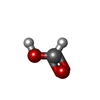[English] 日本語
 Yorodumi
Yorodumi- PDB-3efa: Crystal structure of putative N-acetyltransferase from Lactobacil... -
+ Open data
Open data
- Basic information
Basic information
| Entry | Database: PDB / ID: 3efa | ||||||
|---|---|---|---|---|---|---|---|
| Title | Crystal structure of putative N-acetyltransferase from Lactobacillus plantarum | ||||||
 Components Components | Putative Acetyltransferase | ||||||
 Keywords Keywords |  TRANSFERASE / TRANSFERASE /  acetyltransferase / acetyltransferase /  Lactobacillus plantarum / Lactobacillus plantarum /  Structural Genomics / PSI-2 / Structural Genomics / PSI-2 /  Protein Structure Initiative / Midwest Center for Structural Genomics / MCSG Protein Structure Initiative / Midwest Center for Structural Genomics / MCSG | ||||||
| Function / homology |  Function and homology information Function and homology informationglucosamine 6-phosphate N-acetyltransferase activity / UDP-N-acetylglucosamine biosynthetic process /  Transferases; Acyltransferases; Transferring groups other than aminoacyl groups Transferases; Acyltransferases; Transferring groups other than aminoacyl groupsSimilarity search - Function | ||||||
| Biological species |   Lactobacillus plantarum WCFS1 (bacteria) Lactobacillus plantarum WCFS1 (bacteria) | ||||||
| Method |  X-RAY DIFFRACTION / X-RAY DIFFRACTION /  SYNCHROTRON / SYNCHROTRON /  SAD / Resolution: 2.423 Å SAD / Resolution: 2.423 Å | ||||||
 Authors Authors | Chang, C. / Li, H. / Cobb, G. / Joachimiak, A. / Midwest Center for Structural Genomics (MCSG) | ||||||
 Citation Citation |  Journal: To be Published Journal: To be PublishedTitle: Crystal structure of putative N-acetyltransferase from Lactobacillus plantarum Authors: Chang, C. / Li, H. / Cobb, G. / Joachimiak, A. | ||||||
| History |
|
- Structure visualization
Structure visualization
| Structure viewer | Molecule:  Molmil Molmil Jmol/JSmol Jmol/JSmol |
|---|
- Downloads & links
Downloads & links
- Download
Download
| PDBx/mmCIF format |  3efa.cif.gz 3efa.cif.gz | 71.4 KB | Display |  PDBx/mmCIF format PDBx/mmCIF format |
|---|---|---|---|---|
| PDB format |  pdb3efa.ent.gz pdb3efa.ent.gz | 57.3 KB | Display |  PDB format PDB format |
| PDBx/mmJSON format |  3efa.json.gz 3efa.json.gz | Tree view |  PDBx/mmJSON format PDBx/mmJSON format | |
| Others |  Other downloads Other downloads |
-Validation report
| Arichive directory |  https://data.pdbj.org/pub/pdb/validation_reports/ef/3efa https://data.pdbj.org/pub/pdb/validation_reports/ef/3efa ftp://data.pdbj.org/pub/pdb/validation_reports/ef/3efa ftp://data.pdbj.org/pub/pdb/validation_reports/ef/3efa | HTTPS FTP |
|---|
-Related structure data
| Similar structure data | |
|---|---|
| Other databases |
- Links
Links
- Assembly
Assembly
| Deposited unit | 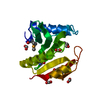
| ||||||||
|---|---|---|---|---|---|---|---|---|---|
| 1 | 
| ||||||||
| Unit cell |
| ||||||||
| Components on special symmetry positions |
|
- Components
Components
| #1: Protein |  Mass: 16723.426 Da / Num. of mol.: 1 Source method: isolated from a genetically manipulated source Source: (gene. exp.)   Lactobacillus plantarum WCFS1 (bacteria) Lactobacillus plantarum WCFS1 (bacteria)Gene: lp_1797 / Plasmid: pMCSG7 / Production host:   Escherichia coli (E. coli) / Strain (production host): BL21(DE3) derivatives / References: UniProt: Q88W61, UniProt: F9UPE4*PLUS Escherichia coli (E. coli) / Strain (production host): BL21(DE3) derivatives / References: UniProt: Q88W61, UniProt: F9UPE4*PLUS | ||||||
|---|---|---|---|---|---|---|---|
| #2: Chemical | ChemComp-FMT /  Formic acid Formic acid#3: Chemical | ChemComp-GOL / |  Glycerol Glycerol#4: Chemical | ChemComp-PO4 / |  Phosphate Phosphate#5: Water | ChemComp-HOH / |  Water Water |
-Experimental details
-Experiment
| Experiment | Method:  X-RAY DIFFRACTION / Number of used crystals: 1 X-RAY DIFFRACTION / Number of used crystals: 1 |
|---|
- Sample preparation
Sample preparation
Crystal grow | Temperature: 289 K / Method: vapor diffusion, sitting drop / pH: 6.5 Details: 0.1M Bis-TRIS 0.5M Magnesium formate, pH 6.5, VAPOR DIFFUSION, SITTING DROP, temperature 289K |
|---|
-Data collection
| Diffraction | Mean temperature: 100 K |
|---|---|
| Diffraction source | Source:  SYNCHROTRON / Site: SYNCHROTRON / Site:  APS APS  / Beamline: 19-ID / Wavelength: 0.97931 Å / Beamline: 19-ID / Wavelength: 0.97931 Å |
| Detector | Type: ADSC QUANTUM 315 / Detector: CCD / Date: Jul 27, 2008 |
| Radiation | Monochromator: double crystal / Protocol: SINGLE WAVELENGTH / Monochromatic (M) / Laue (L): M / Scattering type: x-ray |
| Radiation wavelength | Wavelength : 0.97931 Å / Relative weight: 1 : 0.97931 Å / Relative weight: 1 |
| Reflection | Resolution: 2.4→50 Å / Num. all: 14713 / Num. obs: 14578 / % possible obs: 99.1 % / Observed criterion σ(I): -3 / Redundancy: 12.2 % / Biso Wilson estimate: 54 Å2 / Rmerge(I) obs: 0.112 / Net I/σ(I): 48.35 |
| Reflection shell | Resolution: 2.4→2.42 Å / Redundancy: 13.8 % / Rmerge(I) obs: 0.537 / Mean I/σ(I) obs: 6.9 / Num. unique all: 332 / % possible all: 100 |
- Processing
Processing
| Software |
| ||||||||||||||||||||||||||||||||||||||||||||||||||||||||||||||||||||||||||||||||||||||||||||||||||||
|---|---|---|---|---|---|---|---|---|---|---|---|---|---|---|---|---|---|---|---|---|---|---|---|---|---|---|---|---|---|---|---|---|---|---|---|---|---|---|---|---|---|---|---|---|---|---|---|---|---|---|---|---|---|---|---|---|---|---|---|---|---|---|---|---|---|---|---|---|---|---|---|---|---|---|---|---|---|---|---|---|---|---|---|---|---|---|---|---|---|---|---|---|---|---|---|---|---|---|---|---|---|
| Refinement | Method to determine structure : :  SAD / Resolution: 2.423→35.877 Å / SU ML: 0.3 / σ(F): 0 / Stereochemistry target values: ML SAD / Resolution: 2.423→35.877 Å / SU ML: 0.3 / σ(F): 0 / Stereochemistry target values: ML
| ||||||||||||||||||||||||||||||||||||||||||||||||||||||||||||||||||||||||||||||||||||||||||||||||||||
| Solvent computation | Shrinkage radii: 0.9 Å / VDW probe radii: 1.11 Å / Solvent model: FLAT BULK SOLVENT MODEL / Bsol: 68.757 Å2 / ksol: 0.343 e/Å3 | ||||||||||||||||||||||||||||||||||||||||||||||||||||||||||||||||||||||||||||||||||||||||||||||||||||
| Refinement step | Cycle: LAST / Resolution: 2.423→35.877 Å
| ||||||||||||||||||||||||||||||||||||||||||||||||||||||||||||||||||||||||||||||||||||||||||||||||||||
| Refine LS restraints |
| ||||||||||||||||||||||||||||||||||||||||||||||||||||||||||||||||||||||||||||||||||||||||||||||||||||
| LS refinement shell | Refine-ID: X-RAY DIFFRACTION
| ||||||||||||||||||||||||||||||||||||||||||||||||||||||||||||||||||||||||||||||||||||||||||||||||||||
| Refinement TLS params. | Method: refined / Refine-ID: X-RAY DIFFRACTION
| ||||||||||||||||||||||||||||||||||||||||||||||||||||||||||||||||||||||||||||||||||||||||||||||||||||
| Refinement TLS group |
|
 Movie
Movie Controller
Controller






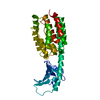


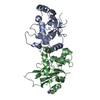

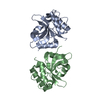
 PDBj
PDBj


